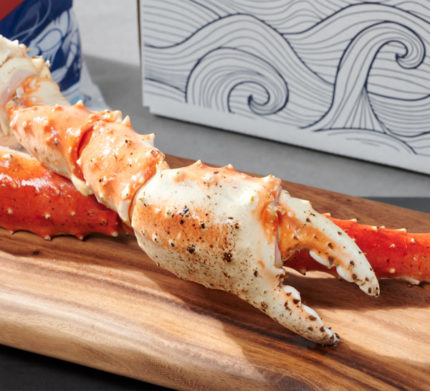
Lobster Tails: Health Benefits, Recipes and Nutritional Facts
Lobster tails, a delicacy enjoyed for their rich taste and texture, are also recognized for their nutritional value. These seafood favorites are not only a luxurious treat but also incorporate a variety of beneficial nutrients that align with a health-conscious diet. The nutrition facts of lobster tails show them to be a low-fat, low-carb, and high-protein option, which can be an excellent part of a balanced diet. The protein content supports muscle growth and repair, making it a valuable food for those focused on fitness and health.
When considering the health benefits of lobster tails, it's essential to assess both the protein content and the presence of omega-3 fatty acids. The latter are known for their positive effects on heart health and inflammation reduction. However, how lobster tails are prepared and served can significantly affect their overall health profile. Accompaniments such as melted butter and mayonnaise-based sauces can increase the meal's calorie and saturated fat content. Therefore, the preparation method is crucial in maintaining the health advantages of consuming lobster tails.
Key Takeaways
- Lobster tails offer a high-protein and low-carbohydrate option suitable for balanced nutrition.
- Omega-3 fatty acids in lobster tails contribute to heart health and anti-inflammatory benefits.
- Preparation methods can impact the nutritional value of lobster tails, influencing their health benefits.
Nutrition Profile of Lobster Tails
Lobster tails are recognized for their rich nutritional value, offering a bounty of essential proteins, vitamins, and minerals while being low in calories and fats. They are an excellent source of lean protein and essential omega-3 fatty acids.
Protein Content
Lobster tails are an excellent source of lean protein, significantly contributing to muscle building and repair. A serving typically contains about 27 grams of protein, vital for a well-balanced diet.
Vitamins and Minerals
Lobster tails are particularly high in selenium and vitamin B12 and rich in various vitamins and minerals. They also provide good zinc, phosphorus, magnesium, and calcium. These nutrients support a range of bodily functions, from bone health to immune system strength.
Healthy Fats
Although lobster tails contain fat, they are notably high in omega-3 fatty acids, including EPA and DHA. These omega-3s are crucial for heart health and cognitive functions. They are low in saturated fat, making them a heart-healthy choice.
Caloric Information
Lobster tails are considered a low-calorie food. An average-sized lobster tail contains approximately 130 calories, which fits nicely into a calorie-conscious eating plan.
Macronutrient Balance
In terms of macronutrient balance, lobster tails offer a powerful package. They include almost no carbohydrates, no fiber, and no sugar. The balance of high protein, low fat, and virtually no carbs positions lobster tails as an ideal constituent of a healthy diet.
Health Benefits of Eating Lobster
Lobster tails are a source of high-quality protein and contains nutrients beneficial for the heart, brain, thyroid, and immune system. Below are specific health advantages associated with incorporating Lobster into a balanced diet.
Heart Health Promotion
Lobster tail is low in saturated fat and can contribute to maintaining healthy blood cholesterol levels, which is crucial for reducing the risk of heart disease. This seafood is high in omega-3 fatty acids, known for their role in heart health and potentially lowering the levels of LDL ("bad" cholesterol).
Brain and Thyroid Function
The iodine content in Lobster is necessary for proper thyroid function, which regulates various bodily processes, including metabolism and hormone balance. Additionally, Lobster contains selenium, an antioxidant that may support mental health and cognitive function.
Immune System Support
Lobster tail contributes to a healthy immune system due to its zinc content, essential for immunity. Regular consumption of zinc found in Lobster may support the body's ability to ward off infections.
Culinary Techniques and Nutritional Impact
Cooking Methods
Cooking lobster tails can be performed through various methods, each affecting the nutritional value differently. Grilling yields a smoky flavor and can help maintain the protein's integrity without excess fat. Baked lobster tail is another healthful option, often requiring minimal additional fats. Steaming or boiling is the most traditional approach, producing a boiled lobster that retains most of its protein content and minerals without adding calories.
- Grilled Lobster: Quick and uses high heat with minimal oil.
- Baked Lobster Tail: Allows for even cooking with the potential for herb infusions.
- Boiled Lobster: Maintains most of the Lobster's natural flavor and nutrients.
10 Popular Lobster Recipes
As a seafood delicacy, Lobster is loved by many for its succulent and sweet taste. With its versatility in different dishes, Lobster has become one of the most sought-after seafood ingredients in the world.
1. Lobster Roll
This recipe is simple yet a classic for Lobster lovers. The Lobster meat is mixed with mayonnaise and served in a soft, toasted bun. Add a touch of fresh lemon juice for a zesty kick to the dish.
2. Lobster Bisque
This creamy soup simmers the Lobster shell and aromatics in a rich broth and then purees the mixture. The fragrant soup is topped with chunks of cooked Lobster meat for a hearty and delicious meal.
3. Lobster Pasta
This dish offers a delightful twist to traditional pasta dishes. The Lobster pieces are tossed with spaghetti, olive oil, garlic, and cherry tomatoes. Mixing the seafood with the spaghetti and simple seasonings creates an unforgettable savory and refreshing flavor.
4. Lobster Stew
A hearty and comforting dish, Lobster stew is made by cooking the Lobster meat in a creamy broth infused with wholesome vegetables. The result is a healthy, velvety stew that's simultaneously luxuriously rich and homey.
5. Lobster Salad
This recipe incorporates steamed or boiled Lobster meat torn into bite-size pieces tossed with fresh greens, cherry tomatoes, feta cheese, and a zingy vinaigrette dressing. This light, refreshing salad is perfect for those seeking a healthy option.
6. Lobster Mac and Cheese
This dish elevates your regular mac and cheese staple with luxurious chunks of Lobster meat. Combining creamy cheese sauce and juicy seafood creates an irresistible, rich flavor.
7. Lobster Tacos
With freshly grilled lobster meat, lime wedges, and a creamy sauce, Lobster tacos are the perfect fusion of Mexican and Maine flavors—tacos with Lobster offer a fresh and savory twist on classic dishes.
8. Lobster Thermidor
A French dish, Lobster thermidor takes the luxurious Lobster meat and bakes it with a creamy, rich sauce. The meat is scooped out and mixed with egg yolks, mustard, and more before being poured back into the shell and baked to golden perfection.
9. Lobster Cakes
Like crab cakes, these cakes are made with chunks of Lobster meat. Lightly breaded, they are pan-fried in butter and served with garlic aioli. Lobster cakes are a treat for seafood lovers looking to enjoy the taste of the ocean.
10. Lobster Scampi
This dish is a shrimp scampi-inspired spin-off that uses Lobster meat instead. The garlic butter sauce gives the Lobster meat an added flavor that pairs excellently with pasta or rice.
Healthy Pairings
Complementing Lobster with nutritious sides and toppings can create a well-balanced meal. Steamed or grilled vegetables add fiber and vitamins with minimal calories. Incorporating lean proteins such as fish or salmon alongside the lobster tail ensures a more decadent, slim meal.
- Serve with a side of vegetables: Asparagus, broccoli, or zucchini are popular choices.
- Pair with a lean protein: A small serving of grilled salmon complements the meal.
Considerations for Sauces and Toppings
Adding sauces and toppings can alter the nutritional value of lobster tails. Opting for melted butter should be done judiciously as it significantly increases the fat content. A splash of lemon juice or a lemon wedge can provide flavor without the added calories. Low-fat mayonnaise or yogurt-based dips can be healthier alternatives to traditional butter-based sauces.
- Sauces: Use lemon juice or vinegar-based dressings for flavor without excess fat.
- Toppings: Sprinkle with herbs like parsley or dill; avoid excess salt.
Comparing Lobster Tails to Other Proteins
Lobster tails are a distinctive choice for a healthy diet, characterized by their high protein content and low levels of fat and carbs. They stand out in the protein-rich food category, offering unique nutritional benefits compared to other familiar protein sources.
Seafood Alternatives
Fish and shellfish encompass a variety of seafood options that also provide lean protein. Salmon, for example, is commonly lauded for its protein and rich omega-3 fatty acid content, which supports cardiovascular health. Shrimp and crab, much like Lobster, are crustaceans that offer protein with less fat and calories than most meats. While shrimp is lower in calories, it has a higher cholesterol content than lobster tails.
- Salmon:
- Higher in fat (healthy omega-3s)
- Similar protein content
- Shrimp:
- Lower in calories
- Higher in cholesterol
- Crab:
- Comparable protein
- Less omega-3 content
Meat and Poultry
When comparing lobster tails to meat and poultry, the difference lies in the type and quantity of fats present. Red meat typically contains more saturated fat, which can contribute to higher cholesterol levels if consumed excessively. Poultry, such as chicken or turkey, provides a healthier alternative with lower fat content, yet it often has less of the vitamins and minerals found in lobster tails.
- Red Meat:
- Higher in saturated fat
- Rich in iron
- Poultry:
- Lower in fat
- Less omega-3 content
Lobster tails provide a balanced nutritional profile and can be an excellent part of a protein-focused diet, especially when dietary fat and calorie count considerations are paramount.
Dietary Considerations and Restrictions
When considering lobster tails as part of a diet, navigating through potential dietary restrictions and nutritional guidelines is essential. This will help ensure that consumption aligns with individual health goals and nutritional needs.
Allergies and Intolerances
Lobster tails fall under the shellfish category, which is a common allergen. Those with shellfish allergy should avoid lobster tails to prevent allergic reactions, which can range from mild to severe. Cross-contamination in kitchens can also be a risk factor, so individuals with this allergy must be vigilant even when Lobster is not a direct ingredient in their meal.
Nutritional Guidelines
Lobster tails provide a wealth of nutrition, being a low-fat, low-carb, and low-calorie seafood option. They are also packed with protein, making them suitable for many diet plans. However, despite the healthy aspects, they are relatively high in dietary cholesterol. The current Dietary Guidelines for Americans suggest that while dietary cholesterol is no longer a nutrient of concern for overconsumption, individuals with certain health conditions should monitor their intake.
Nutrient | Consideration |
Cholesterol | High; consume in moderation |
Sodium | Often high; choose fresh over processed. |
Protein | High; suitable for muscle maintenance |
Fat | Low; preferred in healthy diets |
Weight Management
For those focusing on weight management, including lobster tails can be beneficial due to their low-calorie content. Consuming them steamed or boiled without adding high-calorie sauces or butter can aid in maintaining a low-fat approach. The protein in Lobster helps with satiety, which can prevent overeating. However, moderation is vital, especially for individuals managing dietary cholesterol levels.
Storing and Handling Lobster Tails
Regarding lobster tails, proper storage and handling are paramount to ensure safety and optimal freshness. By adhering to recommended practices, you can enjoy delicious lobster tails with peace of mind.
Safe Storage Practices
Lobster tails should be stored in the refrigerator immediately upon purchase. According to the USDA guidelines, seafood requires careful handling to prevent the growth of bacteria. One should place lobster tails in a sealed container or a heavy-duty plastic bag to store them correctly. This minimizes airflow and reduces the risk of cross-contamination. Ensure that the refrigerator's temperature is set between 32°F and 40°F (0°C-4°C) for optimal conditions.
Preparation Techniques
Before cooking lobster tails, handling them with cleanliness in mind is essential. Thawing should be done in the refrigerator if the tails were previously frozen, allowing them to reach a uniform temperature without exposing them to a warm environment that could foster bacterial growth. Additionally, they should be rinsed under cold water and patted dry before preparation.
Shelf Life and Freshness
The shelf life of lobster tails in the refrigerator typically ranges from one to two days. The freshness of lobster tails can be discerned by their firm texture and lack of any unpleasant odor. If properly frozen, the shelf life can extend up to six months without significant loss of quality, but always refer to safe defrosting methods when ready. For the finest experience in taste and quality, consider indulging in Jumbo Canadian Lobster Tails, known for their meaty and satisfying flavor profile.
Risks and Considerations
When considering lobster tails as part of a diet, it's essential to be aware of possible health risks, such as mercury content and high levels of cholesterol and sodium. These factors can affect dietary choices, particularly those with specific health concerns. Additionally, the impact of lobster fishing on the environment and the importance of choosing sustainable seafood should not be overlooked.
Cholesterol and Sodium Content
Lobster tails are known for their notable cholesterol and sodium levels. A single lobster tail can contain a substantial amount of dietary cholesterol, which may concern individuals managing their blood cholesterol levels. Moreover, the salt content used in preparation can raise sodium intake, and those with hypertension should consume it in moderation. Info on lobster tail nutrition provides specific figures for these nutrients.
Sustainability and Seafood Ratings
Sustainability is a crucial consideration for seafood, including Maine lobster. The environmental impact of fishing practices and the health of marine ecosystems are reflected in seafood ratings. Consumers can refer to organizations that monitor and rate seafood sustainability, such as the Seafood Watch by the Monterey Bay Aquarium, to make informed decisions.
Frequently Asked Questions
This section addresses specific queries regarding the health aspects of lobster tail consumption, providing concise, evidence-based responses tailored for those seeking to understand how this seafood fits into their dietary patterns.
How does Lobster tail consumption affect weight loss efforts?
Lobster tail is a low-fat, low-calorie food with a high protein content, making it an excellent option for weight loss diets. The protein helps promote satiety, which can lead to reduced calorie intake.
Can eating lobster tails contribute to a heart-healthy diet?
Yes, eating lobster tails can contribute to a heart-healthy diet, primarily due to omega-3 fatty acids, which are known to support heart health by reducing blood pressure and controlling inflammation.
What is the cholesterol content in lobster tails compared to shrimp?
The lobster tail contains cholesterol, which is comparatively lower than shrimp's. Individuals concerned about cholesterol should consider portion sizes and frequency of consumption.
What are the nutritional facts for a 4 oz portion of lobster tail?
A 4 oz portion of lobster tail typically provides essential nutrients, like protein, with a calorie count much lower than many other protein sources. Specific figures, however, should be referenced from a reputable nutrient database.
Are there inflammatory concerns associated with consuming lobster tails for individuals with dietary restrictions?
Lobster tails contain omega-3 fatty acids, which are anti-inflammatory. However, those with dietary restrictions should consult a healthcare provider, as individual responses to shellfish can vary.



















